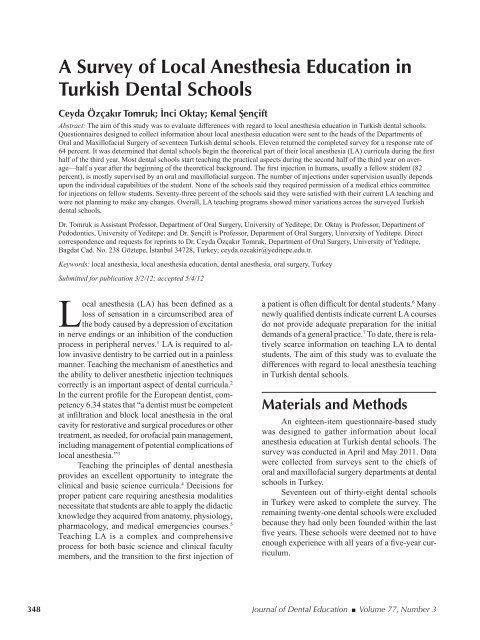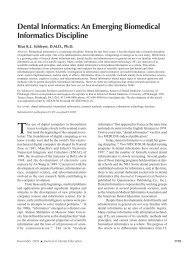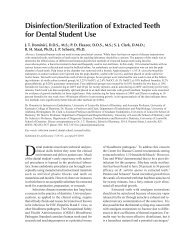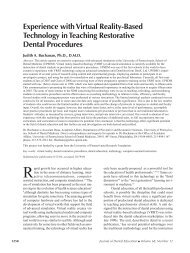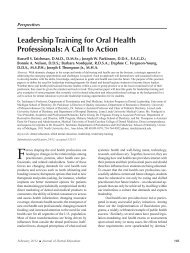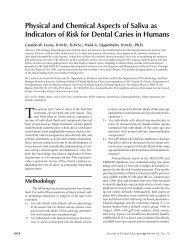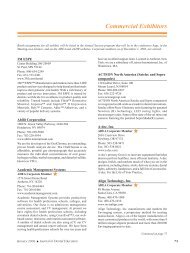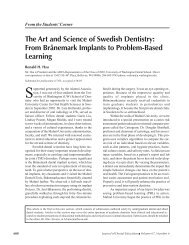A Survey of Local Anesthesia Education in Turkish Dental Schools
A Survey of Local Anesthesia Education in Turkish Dental Schools
A Survey of Local Anesthesia Education in Turkish Dental Schools
You also want an ePaper? Increase the reach of your titles
YUMPU automatically turns print PDFs into web optimized ePapers that Google loves.
A <strong>Survey</strong> <strong>of</strong> <strong>Local</strong> <strong>Anesthesia</strong> <strong>Education</strong> <strong>in</strong><br />
<strong>Turkish</strong> <strong>Dental</strong> <strong>Schools</strong><br />
Ceyda Özçakır Tomruk; İnci Oktay; Kemal S˛ençift<br />
Abstract: The aim <strong>of</strong> this study was to evaluate differences with regard to local anesthesia education <strong>in</strong> <strong>Turkish</strong> dental schools.<br />
Questionnaires designed to collect <strong>in</strong>formation about local anesthesia education were sent to the heads <strong>of</strong> the Departments <strong>of</strong><br />
Oral and Maxill<strong>of</strong>acial Surgery <strong>of</strong> seventeen <strong>Turkish</strong> dental schools. Eleven returned the completed survey for a response rate <strong>of</strong><br />
64 percent. It was determ<strong>in</strong>ed that dental schools beg<strong>in</strong> the theoretical part <strong>of</strong> their local anesthesia (LA) curricula dur<strong>in</strong>g the first<br />
half <strong>of</strong> the third year. Most dental schools start teach<strong>in</strong>g the practical aspects dur<strong>in</strong>g the second half <strong>of</strong> the third year on average—half<br />
a year after the beg<strong>in</strong>n<strong>in</strong>g <strong>of</strong> the theoretical background. The first <strong>in</strong>jection <strong>in</strong> humans, usually a fellow student (82<br />
percent), is mostly supervised by an oral and maxill<strong>of</strong>acial surgeon. The number <strong>of</strong> <strong>in</strong>jections under supervision usually depends<br />
upon the <strong>in</strong>dividual capabilities <strong>of</strong> the student. None <strong>of</strong> the schools said they required permission <strong>of</strong> a medical ethics committee<br />
for <strong>in</strong>jections on fellow students. Seventy-three percent <strong>of</strong> the schools said they were satisfied with their current LA teach<strong>in</strong>g and<br />
were not plann<strong>in</strong>g to make any changes. Overall, LA teach<strong>in</strong>g programs showed m<strong>in</strong>or variations across the surveyed <strong>Turkish</strong><br />
dental schools.<br />
Dr. Tomruk is Assistant Pr<strong>of</strong>essor, Department <strong>of</strong> Oral Surgery, University <strong>of</strong> Yeditepe; Dr. Oktay is Pr<strong>of</strong>essor, Department <strong>of</strong><br />
Pedodontics, University <strong>of</strong> Yeditepe; and Dr. Şençift is Pr<strong>of</strong>essor, Department <strong>of</strong> Oral Surgery, University <strong>of</strong> Yeditepe. Direct<br />
correspondence and requests for repr<strong>in</strong>ts to Dr. Ceyda Özçakır Tomruk, Department <strong>of</strong> Oral Surgery, University <strong>of</strong> Yeditepe,<br />
Bagdat Cad. No. 238 Göztepe, İstanbul 34728, Turkey; ceyda.ozcakir@yeditepe.edu.tr.<br />
Keywords: local anesthesia, local anesthesia education, dental anesthesia, oral surgery, Turkey<br />
Submitted for publication 3/2/12; accepted 5/4/12<br />
<strong>Local</strong> anesthesia (LA) has been def<strong>in</strong>ed as a<br />
loss <strong>of</strong> sensation <strong>in</strong> a circumscribed area <strong>of</strong><br />
the body caused by a depression <strong>of</strong> excitation<br />
<strong>in</strong> nerve end<strong>in</strong>gs or an <strong>in</strong>hibition <strong>of</strong> the conduction<br />
process <strong>in</strong> peripheral nerves. 1 LA is required to allow<br />
<strong>in</strong>vasive dentistry to be carried out <strong>in</strong> a pa<strong>in</strong>less<br />
manner. Teach<strong>in</strong>g the mechanism <strong>of</strong> anesthetics and<br />
the ability to deliver anesthetic <strong>in</strong>jection techniques<br />
correctly is an important aspect <strong>of</strong> dental curricula. 2<br />
In the current pr<strong>of</strong>ile for the European dentist, competency<br />
6.34 states that “a dentist must be competent<br />
at <strong>in</strong>filtration and block local anesthesia <strong>in</strong> the oral<br />
cavity for restorative and surgical procedures or other<br />
treatment, as needed, for or<strong>of</strong>acial pa<strong>in</strong> management,<br />
<strong>in</strong>clud<strong>in</strong>g management <strong>of</strong> potential complications <strong>of</strong><br />
local anesthesia.” 3<br />
Teach<strong>in</strong>g the pr<strong>in</strong>ciples <strong>of</strong> dental anesthesia<br />
provides an excellent opportunity to <strong>in</strong>tegrate the<br />
cl<strong>in</strong>ical and basic science curricula. 4 Decisions for<br />
proper patient care requir<strong>in</strong>g anesthesia modalities<br />
necessitate that students are able to apply the didactic<br />
knowledge they acquired from anatomy, physiology,<br />
pharmacology, and medical emergencies courses. 5<br />
Teach<strong>in</strong>g LA is a complex and comprehensive<br />
process for both basic science and cl<strong>in</strong>ical faculty<br />
members, and the transition to the first <strong>in</strong>jection <strong>of</strong><br />
a patient is <strong>of</strong>ten difficult for dental students. 6 Many<br />
newly qualified dentists <strong>in</strong>dicate current LA courses<br />
do not provide adequate preparation for the <strong>in</strong>itial<br />
demands <strong>of</strong> a general practice. 7 To date, there is relatively<br />
scarce <strong>in</strong>formation on teach<strong>in</strong>g LA to dental<br />
students. The aim <strong>of</strong> this study was to evaluate the<br />
differences with regard to local anesthesia teach<strong>in</strong>g<br />
<strong>in</strong> <strong>Turkish</strong> dental schools.<br />
Materials and Methods<br />
An eighteen-item questionnaire-based study<br />
was designed to gather <strong>in</strong>formation about local<br />
anesthesia education at <strong>Turkish</strong> dental schools. The<br />
survey was conducted <strong>in</strong> April and May 2011. Data<br />
were collected from surveys sent to the chiefs <strong>of</strong><br />
oral and maxill<strong>of</strong>acial surgery departments at dental<br />
schools <strong>in</strong> Turkey.<br />
Seventeen out <strong>of</strong> thirty-eight dental schools<br />
<strong>in</strong> Turkey were asked to complete the survey. The<br />
rema<strong>in</strong><strong>in</strong>g twenty-one dental schools were excluded<br />
because they had only been founded with<strong>in</strong> the last<br />
five years. These schools were deemed not to have<br />
enough experience with all years <strong>of</strong> a five-year curriculum.<br />
348 Journal <strong>of</strong> <strong>Dental</strong> <strong>Education</strong> ■ Volume 77, Number 3
Results<br />
Of the seventeen dental schools contacted,<br />
eleven (64.7 percent) responded to the survey. No response<br />
was received from the rema<strong>in</strong><strong>in</strong>g six schools,<br />
even though notices were sent. The mean number <strong>of</strong><br />
dental students at the schools was 426±174 (between<br />
115 and 700 per school), show<strong>in</strong>g a wide variation;<br />
the mean <strong>of</strong> yearly enrollment <strong>of</strong> dental students<br />
was 100±38.<br />
All <strong>of</strong> the dental schools said they beg<strong>in</strong> the<br />
theoretical background <strong>of</strong> local anesthesia curricula<br />
dur<strong>in</strong>g the first half <strong>of</strong> the third year. On average,<br />
most dental schools beg<strong>in</strong> to teach the practical aspects<br />
dur<strong>in</strong>g the second half <strong>of</strong> the third year, after<br />
the theoretical background has been taught (Table<br />
1). Overall results <strong>of</strong> the survey on teach<strong>in</strong>g <strong>of</strong> local<br />
anesthesia <strong>in</strong> curricula <strong>of</strong> <strong>Turkish</strong> dental schools are<br />
shown <strong>in</strong> Table 2. Most dental schools use textbooks<br />
and syllabi. The theoretical aspects <strong>of</strong> LA education<br />
are assessed by either a written exam<strong>in</strong>ation only<br />
(100 percent) or both written and oral exam<strong>in</strong>ations<br />
(82 percent). Sixty percent <strong>of</strong> the dental schools have<br />
a practical exam<strong>in</strong>ation to evaluate the students’<br />
learn<strong>in</strong>g. In almost half <strong>of</strong> the schools, the students<br />
practiced on non-human objects (e.g., fruits such<br />
as oranges) before they started cl<strong>in</strong>ical practice on<br />
humans. N<strong>in</strong>ety-one percent <strong>of</strong> the surveyed schools<br />
reported be<strong>in</strong>g satisfied with their current local anesthesia<br />
education; only 10 percent were plann<strong>in</strong>g<br />
further changes <strong>in</strong>clud<strong>in</strong>g precl<strong>in</strong>ical tra<strong>in</strong><strong>in</strong>g models.<br />
Discussion<br />
Most practitioners recognize the importance<br />
<strong>of</strong> dental anesthesia education and tra<strong>in</strong><strong>in</strong>g. However,<br />
little consensus exists regard<strong>in</strong>g the extent <strong>of</strong><br />
anesthesia tra<strong>in</strong><strong>in</strong>g that is appropriate for a dental<br />
school’s undergraduate curriculum. This is the first<br />
study to assess theoretical and cl<strong>in</strong>ical tra<strong>in</strong><strong>in</strong>g <strong>in</strong><br />
local anesthesia <strong>in</strong> <strong>Turkish</strong> dental schools. Question-<br />
naires were sent to the heads <strong>of</strong> the Department <strong>of</strong><br />
Oral and Maxill<strong>of</strong>acial Surgery <strong>of</strong> seventeen schools.<br />
Completed questionnaires were returned by eleven<br />
schools, result<strong>in</strong>g <strong>in</strong> a response rate <strong>of</strong> 64.7 percent.<br />
The results show similarities as well as diversities.<br />
One <strong>of</strong> the similarities is that the theoretical<br />
<strong>in</strong>struction is separated from the practical <strong>in</strong>struction<br />
and precedes the cl<strong>in</strong>ical teach<strong>in</strong>g by half a year. One<br />
<strong>of</strong> the differences is <strong>in</strong> adm<strong>in</strong>ister<strong>in</strong>g local anesthetics<br />
on non-human objects prior to start<strong>in</strong>g work <strong>in</strong><br />
the cl<strong>in</strong>ics. At some dental schools, the students<br />
adm<strong>in</strong>istered LA on non-human objects such as an<br />
orange, while the other students performed their<br />
first <strong>in</strong>jection on a fellow dental student. In most<br />
cases (73 percent), dental students performed their<br />
first <strong>in</strong>jection on fellow dental students who do not<br />
require dental treatment, under the supervision <strong>of</strong><br />
an oral and maxill<strong>of</strong>acial surgeon. These results are<br />
consistent with the study conducted by Brand et al. 2<br />
and with older reports about local anesthesia teach<strong>in</strong>g<br />
<strong>in</strong> the United States. 4,8<br />
Electronic tra<strong>in</strong><strong>in</strong>g models have been available<br />
for more than twenty years. However, none <strong>of</strong><br />
the <strong>Turkish</strong> dental schools currently use electronic<br />
tra<strong>in</strong><strong>in</strong>g models before the <strong>in</strong>itial <strong>in</strong>jection on humans<br />
although several dental schools reported plans to <strong>in</strong>troduce<br />
them <strong>in</strong> the near future. Furthermore, there is<br />
no evidence that the electronic tra<strong>in</strong><strong>in</strong>g models have<br />
shown any superiority <strong>in</strong> the teach<strong>in</strong>g <strong>of</strong> local anesthesia.<br />
9 However, <strong>in</strong> the near future, the virtual reality<br />
method may also play an important role <strong>in</strong> tra<strong>in</strong><strong>in</strong>g<br />
students on local anesthesia with the accumulation<br />
<strong>of</strong> more data on its success. 10<br />
Brand et al. evaluated dental students’ op<strong>in</strong>ion<br />
<strong>of</strong> their LA education and reported that programs<br />
and rat<strong>in</strong>g <strong>of</strong> this teach<strong>in</strong>g by dental students show<br />
a wide variation across Europe. 9 However, students’<br />
op<strong>in</strong>ion was not considered <strong>in</strong> our study. It is evident<br />
that feedback from the recipients <strong>of</strong> education will<br />
provide useful <strong>in</strong>formation regard<strong>in</strong>g the best methodology<br />
to familiarize a novice with local anesthetic<br />
techniques.<br />
Table 1. Initial teach<strong>in</strong>g <strong>of</strong> local anesthesia <strong>in</strong> curricula <strong>of</strong> <strong>Turkish</strong> dental schools (n=11)<br />
Initial Teach<strong>in</strong>g Theoretical Background Practical Aspects<br />
Year 3, first half 11 (100%) —<br />
Year 3, second half — 10 (81%)<br />
Year 4, first half — 1 (9%)<br />
March 2013 ■ Journal <strong>of</strong> <strong>Dental</strong> <strong>Education</strong> 349
Table 2. Teach<strong>in</strong>g <strong>of</strong> local anesthesia <strong>in</strong> curricula <strong>of</strong><br />
<strong>Turkish</strong> dental schools (n=11)<br />
Aspect <strong>of</strong> <strong>Education</strong><br />
Number (percentage)<br />
Written material<br />
Syllabus 1 (9%)<br />
Textbook 1 (9%)<br />
Syllabus and textbook 9 (82%)<br />
Assessment type<br />
Written exam<strong>in</strong>ation 11 (100%)<br />
Oral exam<strong>in</strong>ation 9 (82%)<br />
Practical exam<strong>in</strong>ation 7 (64%)<br />
Injection on non-human object<br />
Yes<br />
5 (45%; fruits<br />
such as orange)<br />
No 6 (55%)<br />
First <strong>in</strong>jection on each other<br />
Yes 8 (73%)<br />
No 3 (27%)<br />
First <strong>in</strong>jection on patients requir<strong>in</strong>g<br />
local anesthesia<br />
Yes 4 (36%)<br />
No 7 (64%)<br />
First <strong>in</strong>jection supervised by oral<br />
and maxill<strong>of</strong>acial surgeon<br />
Yes 9 (82%)<br />
No 2 (18%;<br />
other departments)<br />
Need consent to do first <strong>in</strong>jection<br />
on each other<br />
Yes 8 (73%)<br />
No 4 (36%)<br />
Need permission <strong>of</strong> medical ethics<br />
committee to do first <strong>in</strong>jection on<br />
each other<br />
Yes —<br />
No 11 (100%)<br />
Have postgraduate local anesthesia<br />
course<br />
Yes —<br />
No 11 (100%)<br />
Satisfaction with current local<br />
anesthesia education<br />
Yes 10 (91%)<br />
No 1 (9%)<br />
Plann<strong>in</strong>g changes <strong>in</strong> local<br />
anesthesia education<br />
Yes 3 (27%;<br />
to use phantom heads)<br />
No 8 (73%)<br />
<strong>Dental</strong> anesthesia is a very important step <strong>of</strong><br />
dental treatment <strong>in</strong> all aspects <strong>of</strong> the pr<strong>of</strong>ession, and<br />
<strong>in</strong> some cases patients judge the skill and expertise<br />
<strong>of</strong> the practitioner by his or her ability to carry out<br />
a successful anesthesia. Thus, the pr<strong>of</strong>essions must<br />
ensure that qualified anesthetic skills are <strong>in</strong>stilled <strong>in</strong><br />
students prior to graduation so that they will be able<br />
to provide pa<strong>in</strong>less and comfortable dental care to<br />
their patients when they start work<strong>in</strong>g <strong>in</strong>dependently.<br />
Conclusions<br />
Although the response rate limits detailed<br />
<strong>in</strong>terpretation, the results show a m<strong>in</strong>or variation <strong>in</strong><br />
local anesthesia teach<strong>in</strong>g at dental schools <strong>in</strong> Turkey.<br />
When the similarities regard<strong>in</strong>g dental curricula<br />
<strong>in</strong>crease between dental schools, student mobility<br />
with exchange programs may <strong>in</strong>crease all over the<br />
country and world. Future studies regard<strong>in</strong>g the students’<br />
op<strong>in</strong>ions <strong>of</strong> their local anesthesia education are<br />
needed <strong>in</strong> order to support more specific conclusions<br />
on this topic.<br />
REFERENCES<br />
1. Malamed SF. Handbook <strong>of</strong> local anesthesia. 5th ed. St.<br />
Louis: Mosby, 2004.<br />
2. Brand HS, Ku<strong>in</strong> D, Baart JA. A survey <strong>of</strong> local anesthesia<br />
education <strong>in</strong> European dental schools. Eur J Dent Educ<br />
2008;12:85-8.<br />
3. Plasschaert AJM, Holbrook WP, Delap E, et al. Pr<strong>of</strong>ile and<br />
competences for the European dentist. Eur J Dent Educ<br />
2005;9:98-107.<br />
4. Hiatt NW. Correlation <strong>of</strong> teach<strong>in</strong>g local anesthesia, neuroanatomy,<br />
pharmacology, and psychology. J Dent Educ<br />
1970;34(2):179-81.<br />
5. Moore PA, Boynes SG, Cuddy MA, Giovannitti JA Jr,<br />
Zovko J. <strong>Education</strong>al experiences and preparedness <strong>in</strong><br />
dental anesthesia: five-year outcome assessment and<br />
conclusions. J Dent Educ 2009;73(12):1379-86.<br />
6. Jenk<strong>in</strong>s DB, Spackman GK. A method for teach<strong>in</strong>g<br />
the classical <strong>in</strong>ferior alveolar nerve block. Cl<strong>in</strong> Anat<br />
1995;8:231-4.<br />
7. Lev<strong>in</strong>e RS. Experience, skill, and knowledge ga<strong>in</strong>ed by<br />
newly qualified dentists dur<strong>in</strong>g their first year <strong>of</strong> general<br />
practice. Br Dent J 1992;172:97-102.<br />
8. Milgrom P, We<strong>in</strong>ste<strong>in</strong> P, Kaufman E. Student difficulties <strong>in</strong><br />
achiev<strong>in</strong>g local anesthesia. J Dent Educ 1984;48(3):168-<br />
70.<br />
9. Brand HS, Tan LL, van der Spek SJ, Baart JA. European<br />
dental students’ op<strong>in</strong>ions on their local anesthesia education.<br />
Eur J Dent Educ 2011;15(1):47-52.<br />
10. Hanson KM, Jones N, Krantz M, et al. Techniques for<br />
adm<strong>in</strong>ister<strong>in</strong>g local anesthesia utiliz<strong>in</strong>g mixed-reality<br />
technology. J Dent Res 2006;85:1693.<br />
350 Journal <strong>of</strong> <strong>Dental</strong> <strong>Education</strong> ■ Volume 77, Number 3


